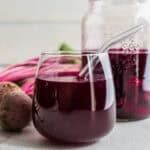How to Make Beet Kvass
A fermented drink that packs an earthy, salty punch, this Beet Kvass recipe is easy to make and has a ton of health benefits. It's perfect to enjoy on an average day or use it as a mocktail mixer for a special brunch.
Servings: 24 Ounces
Equipment
- 1 32 oz (4-cup) mason jar (or other glass jar)
- 1 Kitchen Scale (optional)
Ingredients
- 1 ½ cups chopped beets chopped to ½ inch cubes
- 3 cups filtered water
- 2 teaspoons of salt
Instructions
- Wash a 32 oz (4-cup) mason jar thoroughly with hot, soapy water. Rinse and dry.
- Wash the beets well, leaving the skin on.
- Dice the beets into ½-inch pieces. (Tip: Place a sheet of parchment paper on your cutting board to prevent staining.)
- Measure out 1½ cups of diced beets.
- Place the empty mason jar on a kitchen scale and press "tare" to zero out the weight.
- Add the beets to the jar, then pour in enough water to fill it completely.
- Take note of the total weight in grams (beets + water). Alternatively, you can use approximately 3 cups of water, just make sure that it fills the jar.
- To determine the amount of salt needed, multiply the total weight by 0.015 (for a 1.5% brine). Example: If the combined weight is 860 grams, multiply 860 by 0.015 to get 12. You would add 12 grams of salt.
- Tare the scale again and add the calculated amount of salt. Alternatively, you can add 2 teaspoons of salt for every 3 cups of water.
- Secure the lid and shake well until the salt is fully dissolved.
- Ensure the beets stay fully submerged under the brine. You can use fermentation weights, a small pinch bowl, or another small mason jar to keep them down.
- Seal the jar and place it at room temperature, away from direct sunlight.
- Let it ferment for 3 to 5 days, tasting daily.
- Each day, slightly open the lid to release built-up pressure, then reseal.
- Once the kvass reaches your desired flavor (longer fermentation = tangier, less salty taste), strain it into a clean mason jar, discarding the beets.
- Transfer the strained kvass to the fridge to slow the fermentation process.
- Pour yourself a small glass of this nourishing tonic and store the rest in the fridge.
Notes
- If you do not have a kitchen scale, you can use volume measurements. I recommend 3 cups of water and 2 teaspoons of salt. Just be sure the water fills the mason jar.
- Too salty for you? Lacto-ferments like beet kvass generally taste less salty the longer they ferment.
- To speed up the ferment, you can add a few teaspoons of a fermentation liquid from a ferment you already have stored in the fridge like sauerkraut juice.
- You can also use the beets from the ferment! We love to eat them as a side for dinner, a salad topping, or a snack. It's just another way you can get all those vitamins, minerals, and probiotics.
- As with any fermentation, if you see mold or it has a weird smell, you should discard your ferment and try again. it should smell tangy, like other salty brines. If you see a white foam on the top of the liquid, it is probably kahm yeast. You can scrap it off and proceed.
Nutrition
Serving: 2Ounces | Calories: 4kcal | Carbohydrates: 1g | Protein: 0.1g | Fat: 0.01g | Saturated Fat: 0.003g | Polyunsaturated Fat: 0.01g | Monounsaturated Fat: 0.003g | Sodium: 202mg | Potassium: 28mg | Fiber: 0.2g | Sugar: 1g | Vitamin A: 3IU | Vitamin C: 0.4mg | Calcium: 2mg | Iron: 0.1mg
